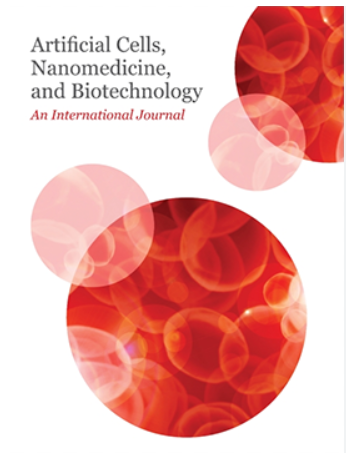核壳静电纺布洛芬聚乙二醇/丝纤维膜预防腹膜粘连的形成
IF 4.5
3区 生物学
Q1 BIOTECHNOLOGY & APPLIED MICROBIOLOGY
Artificial Cells, Nanomedicine, and Biotechnology
Pub Date : 2022-03-17
DOI:10.1080/21691401.2021.1883043
引用次数: 4
摘要
粘连带是形成于组织和器官中间的病理性纤维组织,常引起肠梗阻和女性不孕症。在这里,我们分别探讨了PEG/silk和布洛芬负载的PEG/silk核壳纳米纤维膜的抗粘附和炎症能力。采用静电纺丝法制备了布洛芬负载的丝素-聚乙二醇(SF-PEG)核壳膜,并对其形貌、表面润湿性、药物释放和降解性能进行了研究。为了揭示膜抑制粘附带的能力,将膜缝合在腹膜和腹膜之间,然后使用两种评分粘附系统进行评估。结果表明,纤维膜阻碍了细胞的增殖,评分系统和病理学显示,在大鼠模型中,布洛芬负载的PEG/Silk核壳膜使术后粘连带减轻,动物模型中炎症反应程度较低。总的来说,我们制备了具有抗粘附和抗炎症特性的新型布洛芬负载PEG/SF膜。此外,这种核-壳电纺纤维膜甚至现在还没有被用来防止腱鞘粘连的产生。本文章由计算机程序翻译,如有差异,请以英文原文为准。
Prevention of peritoneal adhesions formation by core-shell electrospun ibuprofen-loaded PEG/silk fibrous membrane
Abstract Adhesion bands are pathological fibrous tissues that create in the middle of tissues and organs, often reasons of intestinal obstruction, and female infertility. Here, we explored the anti-adhesive and inflammatory capacities of PEG/silk and Ibuprofen-loaded PEG/Silk core-shell nanofibrous membranes, respectively. The ibuprofen-loaded Silk Fibroin-Poly ethylene Glycol (SF-PEG) core-shell membrane was fabricated by electrospinning and considered in terms of morphology, surface wettability, drug release, and degradation. To reveal the membrane capability for adhesion bands inhibition, the membrane was stitched among the abdominal partition and peritoneum and then evaluated using two scoring adhesion systems. According to results, the fibrous membrane hindered cell proliferation, and the scoring systems and pathology showed that in a rat model, Ibuprofen-loaded PEG/Silk core-shell membrane caused a lightening in post-operative adhesion bands and the low-grade inflammatory reaction in animal models. Collectively, we fabricated new ibuprofen-loaded PEG/SF membranes with anti-adhesion and anti-inflammation properties. Moreover, this core-shell electrospun fibrous membrane has not even now been used to prevent peritendinous adhesion generation.
求助全文
通过发布文献求助,成功后即可免费获取论文全文。
去求助
来源期刊

Artificial Cells, Nanomedicine, and Biotechnology
BIOTECHNOLOGY & APPLIED MICROBIOLOGY-ENGINEERING, BIOMEDICAL
CiteScore
10.90
自引率
0.00%
发文量
48
审稿时长
20 weeks
期刊介绍:
Artificial Cells, Nanomedicine and Biotechnology covers the frontiers of interdisciplinary research and application, combining artificial cells, nanotechnology, nanobiotechnology, biotechnology, molecular biology, bioencapsulation, novel carriers, stem cells and tissue engineering. Emphasis is on basic research, applied research, and clinical and industrial applications of the following topics:artificial cellsblood substitutes and oxygen therapeuticsnanotechnology, nanobiotecnology, nanomedicinetissue engineeringstem cellsbioencapsulationmicroencapsulation and nanoencapsulationmicroparticles and nanoparticlesliposomescell therapy and gene therapyenzyme therapydrug delivery systemsbiodegradable and biocompatible polymers for scaffolds and carriersbiosensorsimmobilized enzymes and their usesother biotechnological and nanobiotechnological approachesRapid progress in modern research cannot be carried out in isolation and is based on the combined use of the different novel approaches. The interdisciplinary research involving novel approaches, as discussed above, has revolutionized this field resulting in rapid developments. This journal serves to bring these different, modern and futuristic approaches together for the academic, clinical and industrial communities to allow for even greater developments of this highly interdisciplinary area.
 求助内容:
求助内容: 应助结果提醒方式:
应助结果提醒方式:


